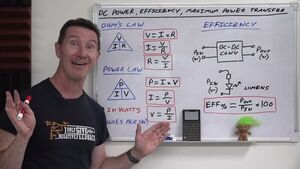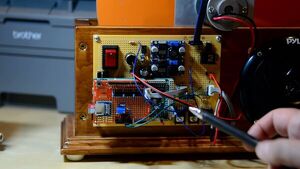2021-06-24 - Nº 321
Editorial
Esta é a Newsletter Nº 321 que se apresenta com o mesmo formato que as anteriores. Se gostar da Newsletter partilhe-a!
Todas as Newsletters encontram-se indexadas no link.
Esta Newsletter tem os seguintes tópicos:
Faz hoje anos que nascia, em 1771, o industrial franco-americano Éleuthère Irénée du Pont. Ele emigrou após a Revolução Francesa de França para os Estados Unidos em 1800. A partir de 1788, trabalhou para o químico francês Antoine Lavoisier, então chefe dos trabalhos reais em pó, e tornou-se o seu primeiro assistente em 1791. Assim, teve o conhecimento para reconhecer uma oportunidade de fabricar pólvora nos EUA, e em 1803 tinha estabelecido um pequeno moinho em Wilmington, Delaware. Ordens governamentais durante a guerra americana de 1812 fizeram da Du Pont o principal fabricante dos EUA. Desde este início, diversificou com interesses num moinho de lã, uma fábrica de algodão, um curtume e tornou-se director do Banco dos Estados Unidos.
Faz também hoje anos que nascia, em 1835, o químico alemão Johannes Wislicenus. O seu trabalho pioneiro levou ao reconhecimento da importância da disposição espacial dos átomos dentro de uma molécula. É conhecido pelo seu trabalho sobre os ácidos lácticos, e em particular pelas suas descobertas no estudo do isomerismo geométrico (a existência de fórmulas idênticas com propriedades químicas diferentes) dos compostos orgânicos.
Faz igualmente hoje anos que nascia, em 1880, o matemático norte-americano Oswald Veblen. Ele deu importantes contribuições na topologia inicial, e na geometria projectiva e diferencial - trabalho que encontrou aplicações na física atómica e na teoria da relatividade. Em 1905, ele provou o teorema da curva do Jordão, que afirma que cada loop não auto-intersectante no plano divide o plano num "interior" e um "exterior". Embora possa parecer óbvio na sua afirmação, é um teorema muito difícil de provar. Durante a II Guerra Mundial, ele esteve envolvido na supervisão do trabalho que produziu o computador digital electrónico pioneiro ENIAC. O seu nome é comemorado pelo Prémio Oswald Veblen da American Mathematical Society. Atribuído de cinco em cinco anos, é o prémio de maior prestígio em reconhecimento da notável investigação em geometria.
Faz também hoje anos que nascia, em 1883, o físico austríaco-americano Victor Francis Hess. Ele partilhou (com Carl D. Anderson dos Estados Unidos) o Prémio Nobel da Física em 1936 pela sua descoberta dos raios cósmicos (radiação de alta energia originada no espaço exterior). Por meio de instrumentos transportados em balões, Hess e outros provaram que a radiação que ioniza a atmosfera é de origem cósmica. Ele observou um ciclo de 27 dias de intensidade de radiação cósmica ao campo magnético do sol e correlacionou-o com o período de 27 dias de rotação do sol. Também trabalhou na concepção de métodos para a detecção de quantidades mínimas de substâncias radioactivas. Hess fez contribuições básicas para uma compreensão da radiação e dos seus efeitos sobre o corpo humano.
Faz igualmente hoje anos que nascia, em 1909, o físico nuclear britânico William Penney. Ele liderou o desenvolvimento da bomba atómica na Grã-Bretanha. Penney esteve na Grã-Bretanha como Robert Oppenheimer esteve nos EUA. Foi uma parte proeminente da Missão Britânica em Los Alamos durante a II Guerra Mundial, onde a sua principal missão era estudar os efeitos nocivos da explosão da bomba atómica, mas também se envolveu em estudos de implosão. A combinação de perícia, habilidade analítica, comunicação eficaz, e a capacidade de os traduzir em aplicação prática, fizeram dele um dos cinco membros do "brain trust" de Los Alamos que tomou decisões chave. Ele foi o único britânico a fazer parte do Comité dos Dez Homens Alvo que elaborou a lista de alvos para o bombardeamento atómico do Japão.
Faz também hoje anos que nascia, em 1915, o astrónomo e matemático inglês Fred Hoyle. Ele é mais conhecido como o principal proponente e defensor da teoria do estado estacionário do universo. Esta teoria sustenta que o universo está em expansão e que a matéria está a ser continuamente criada para manter constante a densidade média da matéria no espaço. Tornou-se o astrónomo mais conhecido da Grã-Bretanha em 1950 com as suas palestras sobre A Natureza do Universo, e lembrou-se de cunhar o termo "Big Bang" na última dessas palestras. Embora ao longo do tempo, a crença num universo em "estado estável" como Hoyle tinha proposto foi partilhada por cada vez menos cientistas devido a novas descobertas, Hoyle nunca aceitou a agora mais popular teoria do "Big Bang" para a origem do universo.
Por fim, faz hoje anos que nascia, em 1927, o físico americano Martin Perl. Ele recebeu o Prémio Nobel da Física de 1995 por ter descoberto uma partícula subatómica a que deu o nome de tau, um leptão maciço com uma carga negativa. O tau, que encontrou em meados dos anos 70, foi a primeira prova de uma terceira "geração" de partículas fundamentais. É um primo super-pesado do electrão, idêntico em todos os aspectos, excepto que o tau é mais de 3.500 vezes mais pesado que o electrão e sobrevive menos de um trilião de segundo, enquanto que o electrão é estável.
Faz hoje 22 anos que a sonda Cassini da NASA voo perto de Vénus na sua jornada até Saturno. Aproveitando a gravidade de Vénus, a Cassini ganhou impulso suficiente durante o encontro para passar a cintura de asteróides. Depois de Vénus, a Cassini voou pela Terra, pela Lua e por Júpiter antes de chegar a Saturno. Toda a viagem de Vénus a Saturno demorou cerca de cinco anos.
Hoje a Microsoft lançou a nova versão do seu Sistema - o Windows 11. Este novo sistema simplifica o design e a experiência do utilizador para potenciar a sua produtividade e inspirar a sua criatividade. É moderno, fresco, limpo e bonito. Desde o novo botão Start e barra de tarefas até cada som, fonte e ícone, tudo foi feito intencionalmente para o colocar no controlo e trazer uma sensação de calma e facilidade. Foi colocado o botão de Start no centro e tornou-se mais fácil encontrar rapidamente o que precisa. Start utiliza o poder da nuvem e do Microsoft 365 para lhe mostrar os seus ficheiros recentes, independentemente da plataforma ou dispositivo em que os estava a visualizar anteriormente, mesmo que estivesse num dispositivo Android ou iOS. Os requisitos mínimos também foram incrementados relativamente ao Windows 10 e passa ser exigido um processador de 64 bits de pelo menos 1 Ghz, mínimo de 4 GB de memória, 64 GB de disco, sistema de boot UEFI e dispositivo de apresentação de pelo menos 9 polegadas com 1366x768 de resolução minima e compatível com o DirectX 12.
É também hoje que é possível observar a primeira lua cheia deste verão. A lua cheia desta noite é também uma super-lua, que ocorre quando a lua está no seu ponto mais próximo da Terra na sua órbita, também conhecida como perigeu. Por sua vez, a lua parecerá ligeiramente maior e mais brilhante, uma vez que está mais próxima da Terra do que é habitual. A Lua de Morangueiro de Junho é a segunda e última super-lua do ano.
Na Newsletter desta semana apresentamos diversas noticias, artigos científicos, projetos de maker assim como alguns videos interessantes. É apresentada a revista MagPI Nº107 de Julho.
 João Alves ([email protected])
João Alves ([email protected])
O conteúdo da Newsletter encontra-se sob a licença  Creative Commons Attribution-NonCommercial-ShareAlike 4.0 International License.
Creative Commons Attribution-NonCommercial-ShareAlike 4.0 International License.
Novidades da Semana

Introducing Windows 11
"At a time when the PC is playing a more central role in our lives, Windows 11 is designed to bring you closer to what you love. Windows has always existed to be a stage for the world’s innovation. It’s been the backbone of global businesses and where scrappy startups became household names. The web was born and grew up on Windows. It’s the place where many of us wrote our first email, played our first PC game and wrote our first line of code. Windows is the place people go to create, to connect, to learn and to achieve – a platform over a billion people today rely on." [...]

The full Strawberry Moon, the last supermoon of 2021, rises tonight! Here’s what to expect
"The first full moon of summer 2021, also known as the Strawberry Moon, rises tonight (June 24), marking the last supermoon of the year. June’s full moon arrives Thursday (June 24) at 2:40 p.m. EDT (1940 GMT). Technically, the moon will officially be full before it appears above the horizon, as the full moon rises in the eastern sky at 8:53 p.m. EDT (0053 Friday GMT). The moon will appear full for about three days, starting early Wednesday (June 23) morning through early Saturday (June 26) morning, according to a statement from NASA. Tonight’s full moon is also a supermoon, which occurs when the moon is at its closest point to Earth in its orbit, also known as perigee. In turn, the moon will look slightly bigger and brighter since it's closer to the Earth than usual." [...]
Outras Notícias
Samsung Introduces New 5G Radio with Integrated Antennas
"Driving greater deployment efficiency in a compact form factor, Samsung’s new One Antenna Radio is built to accelerate 5G rollouts Samsung Electronics today unveiled a new radio designed to help mobile operators overcome the challenges they face in deploying 5G networks. Announced at “Samsung Networks: Redefined,” the new One Antenna Radio features integrated antennas, providing operators with the ability to simplify and speed up 5G installations by consolidating a 3.5GHz Massive MIMO radio with low-band and mid-band passive antennas into a single form factor. As operators continue to extend their 5G coverage, a key challenge they face is the space and footprint restrictions at sites and on towers. Samsung’s all-in-one radio will address varied environmental and site demands–easing installation, saving space and reducing OPEX for operators. The new solution will become part of Samsung’s Radio Access Network (RAN) portfolio in early 2022, initially targeting the European market. Key benefits of Samsung’s One Antenna Radio are: - Site Simplification: The streamlined solution uses compact hardware to blend into a municipality’s environment, and reduces cabling and hardware elements to minimize visual impact in dense urban areas." [...]

Microchip Boosts Gallium Nitride (GaN) Radio Frequency (RF) Portfolio with Ka-band Monolithic Microwave Integrated Circuit (MMIC) with High Linearity for SatCom Terminals
"The GMICP2731-10 helps maintain signal fidelity by allowing Earth stations to transmit at high RF levels without sacrificing the quality of the signal Satellite communication systems use complex modulation schemes to achieve the blazingly fast data rates required to deliver video and broadband data. To attain this, they must deliver high RF output power while simultaneously ensuring the signals retain their desired characteristics. The new GMICP2731-10 GaN MMIC power amplifier announced today by Microchip Technology Inc. (Nasdaq: MCHP) helps meet both of these requirements. The new device, Microchip’s first GaN MMIC, is designed for use in commercial and defense satellite communications, 5G networks and other aerospace and defense systems. The GMICP2731-10 is fabricated using GaN-on-Silicon Carbide (SiC) technology. It delivers up to 10W of saturated RF output power across the 3.5 GHz of bandwidth between 27.5 to 31 GHz." [...]
Panasonic Commercializes a New Semiconductor Substrate Material Designed to Improve Reliability
"Panasonic Corporation announced today that its Industrial Solutions Company has commercialized a semiconductor package substrate material (Product No. R-1515V) enabling both low package warpage and high assembly-level reliability. The newly developed material has very low thermal expansion properties to reduce warping of the substrate during the packaging process and optimized mechanical properties designed to lower the residual stress on solder joints created during reflow assembly. Mass production of the material will start in July 2021. Semiconductors, the cornerstone of modern electronics, are critical to the advancement of IoT, AI, V2X, 5G and other leading-edge technologies. These devices have continued to improve and evolve in both die performance and packaging designs over time." [...]
Toshiba’s New Device Structure Improves SiC MOSFET High Temperature Reliability and Reduces Power Loss
"Toshiba Electronic Devices & Storage Corporation (“Toshiba”) has developed a new SiC MOSFET device structure that simultaneously achieves higher reliability at high temperatures and lower power loss. In a 3300V chip at 175ºC, a level of current over double that of Toshiba’s present structure, the new structure operates without any loss of reliability, and it also reduces specific on-resistance at room temperature by about 20% for a 3300V chip and 40% for a 1200V chip. Silicon carbide (SiC) is widely seen as the next generation material for power devices, as it delivers higher voltages and lower losses than silicon. While SiC power devices are now mainly utilized in inverters for trains, wider application is on the horizon, including in photovoltaic power systems and the power management systems of industrial equipment. However, the use and market growth of SiC devices have been held back by reliability issues. One problem is the expansion of crystal defects when current flows through the PN diode [4] positioned between a power MOSFET’s source and drain, which increases on-resistance and degrades device reliability." [...]

Maxim Integrated’s Essential Analog Supervisor Delivers Industry’s First Automotive Window Voltage Monitor with Built-In Self-Test for Advanced Driver Assistance Systems
"MAX16137 helps automotive system engineers achieve functional safety while reducing size by 50 percent Designers working to achieve automotive functional safety in Advanced Driver Assistance Systems (ADAS) can now reduce solution size and complexity with the MAX16137 single-window voltage monitor with built-in self-test (BIST) from Maxim Integrated Products, Inc. (NASDAQ: MXIM). This window monitor IC delivers robust protection by tracking both undervoltage and overvoltage levels with 1-percent accuracy allowing designers to accelerate system-wide functional safety by providing advanced diagnostics and reset capabilities. The MAX16137 also cuts solution size in half and helps reduce design complexity. Functional safety standards drive design direction in the automotive space. Voltage monitors play a key role in reporting the health of power supplies. Further, these systems must include test circuits to ensure reliable operation." [...]

STMicroelectronics Extends STM32G0 Microcontroller Series with USB-C Full Speed Dual Role Port, CAN FD, and Larger Memory
"STMicroelectronics has expanded the STM32G0* Arm® Cortex®-M0+ microcontroller (MCU) series with more product variants and features such as dual-bank Flash, support for CAN FD and crystal-less USB Full-Speed data/host support. For budget-conscious applications, the new STM32G050 Value Line and mainstream STM32G051 and STM32G061 MCUs add rich analog features and up to 18KBytes of RAM, with competitively priced package options up to 48-pins. In addition, the STM32G0B0 Value Line, STM32G0B1 and STM32G0C1 MCUs introduce new features to the STM32G0 series by integrating a USB 2.0 device/host controller and dual-bank Flash memory. The STM32G0B1 and STM32G0C1 feature ST’s FDCAN peripheral. With the new variants that combine a USB2.0 Full Speed crystal-less data interface supporting Device and Host modes, and a USB-C Power Delivery controller, STM32G0 allows customers to develop innovative use-cases leveraging dual-role capability to extend the interoperability of new USB-C devices. Now that USB Dual Role is replacing USB On-The-Go (OTG), STM32G0 can easily change between device and host roles and change between power source and power sink with a simple USB Power Delivery command." [...]

New Family of 700V Buck Regulators From Renesas Offers Unmatched Feature Set for Home Appliances, Smart Homes, Sensing Systems, Power Meters and Industrial Controls
"Devices Offer Very Low Power Consumption, Excellent EMI, No Audible Noise, and Reduced BOM Costs; Complement Renesas’ MCU and Sensor Lines Renesas Electronics Corporation (TSE:6723), a premier supplier of advanced semiconductor solutions, today unveiled a family of new 700V buck regulators that offers designers numerous advantages over competitive solutions. The new RAA2230XX devices deliver superior power consumption, noise and EMI suppression, as well as reduced overall system cost. They are ideal for a wide range of applications, including home appliances, sensing systems such as smoke alarms and gas sensors, white goods, power meters and industrial controls. The new RAA2230XX buck regulators consume only 10mW to 30mW when idle, helping system designers meet ever-tightening standby power regulations. They feature a unique switching algorithm which minimizes electromagnetic interference (EMI) and eliminates audible noise, such as ‘humming’ or ‘whining’ that can affect competitors’ solutions. The new regulators also can supply as low as 3.3V output, enabling designers to eliminate a second-stage low dropout regulator (LDO), saving BOM cost and board space." [...]

Innovative Ultra High Density Offline Power Solutions from ON Semiconductor
"ON Semiconductor® (Nasdaq:ON), driving energy efficient innovations, announces industry’s first dedicated critical conduction mode (CrM) totem pole PFC controller as a new addition to their solution set for ultra-high density offline power supplies. In conventional PFC circuits, the rectifier bridge diodes account for around 4 W of losses in a 240 W power supply, representing around 20% of total losses. In contrast, PFC stages are typically 97% efficient and the LLC circuit achieves similar performance. However, replacing the lossy diodes with switches in a ‘totem pole’ configuration and pulling in the boost PFC function can cut down the bridge losses and significantly improve overall efficiency. Further, NCP1680 can accommodate any switch type whether it is super junction silicon MOSFET or Wide Bandgap switches such as Silicon Carbide (SiC) or Gallium Nitride (GaN) devices. The new NCP1680 CrM totem pole PFC controller employs novel current limit architecture and line phase detection while incorporating proven control algorithms to deliver a cost-effective Totem Pole PFC solution without compromising on performance." [...]

The LEGO Group reveals first prototype LEGO® brick made from recycled plastic
"The LEGO Group today unveiled a prototype LEGO® brick made from recycled plastic, the latest step in its journey to make LEGO products from sustainable materials. The new prototype, which uses PET plastic from discarded bottles, is the first brick made from a recycled material to meet the company’s strict quality and safety requirements. A team of more than 150 people are working to find sustainable solutions for LEGO products. Over the past three years, materials scientists and engineers tested over 250 variations of PET materials and hundreds of other plastic formulations. The result is a prototype that meets several of their quality, safety and play requirements – including clutch power. Vice President of Environmental Responsibility at the LEGO Group, Tim Brooks said: “We are super excited about this breakthrough." [...]

Supersonic-jet R&D takes flight in Japan's aerospace sector
"Tired of merely supplying parts for Western aircraft, major Japanese engineering companies including IHI and Mitsubishi Heavy Industries are joining forces with Japan's space agency on research and development in supersonic passenger jets, seen as a key step in the next generation of transportation. Their new public-private initiative, Japan Supersonic Research, was announced Wednesday. Members also include Kawasaki Heavy Industries, Subaru and Japan Aircraft Development Corp. The group aims to participate in international projects with such companies as Boeing, starting around 2030 or so. The project could create new opportunities for Japan's aerospace industry, which is now mostly limited to building wings and fuselages for big aircraft makers elsewhere, such as Boeing and Airbus. Setting up a single research center may enable companies here to not only set a direction for this new technology, but also boost their profit margins." [...]
Ciência e Tecnologia

How To Make Lithium-Ion Batteries Invincible
"In our future electrified world, the demand for battery storage is projected to be enormous, reaching to upwards of 2 to 10 terawatt-hours (TWh) of annual battery production by 2030, from less than 0.5 TWh today. However, concerns are growing as to whether key raw materials will be adequate to meet this future demand. The lithium-ion battery – the dominant technology for the foreseeable future – has a component made of cobalt and nickel, and those two metals face severe supply constraints on the global market. Now, after several years of research led by Lawrence Berkeley National Laboratory (Berkeley Lab), scientists have made significant progress in developing battery cathodes using a new class of materials that provide batteries with the same if not higher energy density than conventional lithium-ion batteries but can be made of inexpensive and abundant metals. Known as DRX, which stands for disordered rocksalts with excess lithium, this novel family of materials was invented less than 10 years ago and allows cathodes to be made without nickel or cobalt. “The classic lithium-ion battery has served us well, but as we consider future demands for energy storage, its reliance on certain critical minerals exposes us not only to supply-chain risks, but also environmental and social issues,” said Ravi Prasher, Berkeley Lab’s Associate Lab Director for Energy Technologies." [...]

New Research Brings Age Of 65M-Year-Old Meteorite Impact Into Sharper Focus
"New research into one of the most volatile periods in Earth’s geological history has narrowed down the precise age of a meteorite impact in the Ukraine around 65 million years ago, ruling out the chance that it contributed to the extinction of the dinosaurs but offering new insight into the planet’s climate history. A team of geologists, led by researchers from the University of Glasgow, applied state-of-the-art dating techniques to samples of melted rock created during the fiery landing of a giant meteorite in Ukraine’s Kivorohad Oblast region. The explosive collision formed a 15-mile-wide basin known as the Boltysh impact crater, which over time filled with water and formed a lake. Previous analysis of samples from the Boltysh crater, undertaken decades ago, suggested that the meteorite may have struck the Earth between two and five thousand years before the Chicxulub meteorite impact in Mexico’s Yucatán Peninsula. The Chicxulub impact is widely believed to have caused the mass extinction event which made non-avian dinosaurs extinct, and the climate event which created the geological signature known as the Cretaceous–Paleogene boundary. However, questions still remained over whether the Boltysh impact might have occurred close enough in time to have had an effect on both." [...]

Low-cost imaging technique shows how smartphone batteries could charge in minutes
"Researchers have developed a simple lab-based technique that allows them to look inside lithium-ion batteries and follow lithium ions moving in real time as the batteries charge and discharge, something which has not been possible until now. Using the low-cost technique, the researchers identified the speed-limiting processes which, if addressed, could enable the batteries in most smartphones and laptops to charge in as little as five minutes. The researchers, from the University of Cambridge, say their technique will not only help improve existing battery materials, but could accelerate the development of next-generation batteries, one of the biggest technological hurdles to be overcome in the transition to a fossil fuel-free world. The results are reported in the journal Nature. While lithium-ion batteries have undeniable advantages, such as relatively high energy densities and long lifetimes in comparison with other batteries and means of energy storage, they can also overheat or even explode, and are relatively expensive to produce. Additionally, their energy density is nowhere near that of petrol." [...]

Team streamlines neural networks to be more adept at computing on encrypted data
"Researchers at the NYU Center for Cyber Security at the NYU Tandon School of Engineering are rethinking basic functions that drive the ability of neural networks to make inferences on encrypted data. Their focus is on linear and non-linear operators, key features of neural network frameworks that, depending on the operation, introduce a heavy toll in time and computational resources. When neural networks compute on encrypted data, many of these costs are incurred by rectified linear activation function (ReLU), a non-linear operation. Brandon Reagen, professor of computer science and engineering and electrical and computer engineering and a team of collaborators including Nandan Kumar Jha, a Ph.D. student, and Zahra Ghodsi, a former doctoral student under the guidance of Siddharth Garg, developed a framework called DeepReDuce that offers a solution through rearrangement and reduction of ReLUs in neural networks. The investigators will present their paper “DeepReDuce: ReLU Reduction for Fast Private Inference” at the 38th International Conference on Machine Learning (ICML 21) in July, 2021. Reagen explained that this shift requires a fundamental reassessment of where and how many components are distributed in neural networks systems." [...]

New Quantum Repeaters Could Enable a Scalable Quantum Internet
"Quantum repeaters that can store multiplexed signals; provide heralded signals of entanglement; and operate at telecommunications wavelengths have been developed by two independent research teams. Their work could prove to be an important step towards the creation of a scalable quantum internet. If it can be built, a quantum internet would allow calculations to be distributed between multiple quantum computers – allowing larger and more complex problems to be solved. A quantum internet would also provide secure communications because eavesdropping on the exchange of quantum information can be easily identified. The backbone of such a quantum network would be quantum-mechanically entangled links between different network points, called nodes. However, creating entangled links over long distances at high data rates remains a challenge." [...]

Cutting Perovskite: Scientists Succeed in Shaping Microscopic Monocrystals Without Loss of Quality
"A research team that includes staff members of ITMO University has suggested a new method of processing miniature perovskite fragments. The method is cheap and makes it possible to fashion microcrystals into desired shapes for use in production of lenses and other optoelectronic elements. This will help bring about the material’s widespread adoption within the industry. A paper on the research was published in Laser & Photonics Reviews. Today, perovskites are among the most actively studied materials. The first perovskite known to science was calcium titanate, a mineral discovered in 1839 in the Ural Mountains." [...]

Solar energy collectors grown from seeds
"Engineers create seeds for growing near-perfect 2D perovskite crystals Rice University engineers have created microscopic seeds for growing remarkably uniform 2D perovskite crystals that are both stable and highly efficient at harvesting electricity from sunlight. Halide perovskites are organic materials made from abundant, inexpensive ingredients, and Rice’s seeded growth method addresses both performance and production issues that have held back halide perovskite photovoltaic technology. In a study published online in Advanced Materials, chemical engineers from Rice’s Brown School of Engineering describe how to make the seeds and use them to grow homogenous thin films, highly sought materials comprised of uniformly thick layers. In laboratory tests, photovoltaic devices made from the films proved both efficient and reliable, a previously problematic combination for devices made from either 3D or 2D perovskites. “We’ve come up with a method where you can really tailor the properties of the macroscopic films by first tailoring what you put into solution,” said study co-author Aditya Mohite, an associate professor of chemical and biomolecular engineering and of materials science and nanoengineering at Rice. “You can arrive at something that is very homogeneous in its size and properties, and that leads to higher efficiency." [...]

First Clear View of a Boiling Cauldron Where Stars are Born
"UMD-led team used NASA’s SOFIA telescope to capture high-resolution details of a star nursery in the Milky Way University of Maryland researchers created the first high-resolution image of an expanding bubble of hot plasma and ionized gas where stars are born. Previous low-resolution images did not clearly show the bubble or reveal how it expanded into the surrounding gas. The researchers used data collected by the Stratospheric Observatory for Infrared Astronomy (SOFIA) telescope to analyze one of the brightest, most massive star-forming regions in the Milky Way galaxy. Their analysis showed that a single, expanding bubble of warm gas surrounds the Westerlund 2 star cluster and disproved earlier studies suggesting there may be two bubbles surrounding Westerlund 2. The researchers also identified the source of the bubble and the energy driving its expansion. Their results were published in The Astrophysical Journal on June 23, 2021." [...]

New Type of Machine Learning Aids Earthquake Risk Prediction
"Our homes and offices are only as solid as the ground beneath them. When that solid ground turns to liquid — as sometimes happens during earthquakes — it can topple buildings and bridges. This phenomenon is known as liquefaction, and it was a major feature of the 2011 earthquake in Christchurch, New Zealand, a magnitude 6.3 quake that killed 185 people and destroyed thousands of homes. An upside of the Christchurch quake was that it was one of the most well-documented in history. Because New Zealand is seismically active, the city had numerous sensors for monitoring earthquakes. Post-event reconnaissance provided a wealth of additional data on how the soil responded across the city." [...]

Going the distance to confirm a galaxy with almost no dark matter
"Three years ago, a team of astronomers led by Yale’s Pieter van Dokkum surprised the scientific community with the discovery of a far-off galaxy that contained little or no dark matter. The discovery, made using NASA’s Hubble Space Telescope, had the potential to upend well-established theories about how galaxies form and evolve. That is because dark matter — the invisible scaffolding that accounts for most of the universe’s mass — is considered essential for creating and shaping galaxies. But how could a galaxy exist with almost no dark matter? Some astronomers speculated the finding was incorrect. Specifically, they questioned the accuracy of distance measurements from Earth to NGC 1052-DF2 — the galaxy with no dark matter." [...]

New material can increase boiler efficiency
"Several years of detective work in the laboratory and sitting at a scanning electron microscope have increased our knowledge of stainless steel. The results may lead to new materials to be used in the boilers of power plants, with higher efficiency, lower emissions and a smaller impact on the climate. Interesting combination That’s exactly how Hugo Wärner describes it: “detective work”. In his doctoral thesis, High Temperature Fatigue Behaviour of Austenitic Stainless Steel: Microstructural Evolution during Dwell-Fatigue and Thermomechanical Fatigue, he investigates the properties of what are known as austenitic stainless steels at high temperature, high pressure and frequent changes in loading. Behind the thesis lie many hours of work with mechanical samples in the laboratory, during which test rods were placed under load until they either cracked or failed completely, followed by investigation of the fracture surfaces in the scanning electron microscope. Then followed analysis of the results and finally writing summary reports." [...]
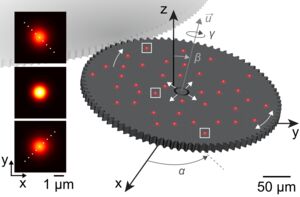
Escape From Flatland: Calibration Method Enables Microscopes to Make Accurate Measurements in All 3 Dimensions
"NIST researchers turn 2D optical imperfections into an advantage for imaging in 3D. Conventional microscopes provide essential information about samples in two dimensions — the plane of the microscope slide. But flat is not all that. In many instances, information about the object in the third dimension — the axis perpendicular to the microscope slide — is just as important to measure. For example, to understand the function of a biological sample, whether it is a strand of DNA, tissue, organ or microscopic organism, researchers would like to have as much information as they can get about the three-dimensional structure and motion of the object. Two-dimensional measurements yield an incomplete and sometimes unsatisfying understanding of the sample." [...]
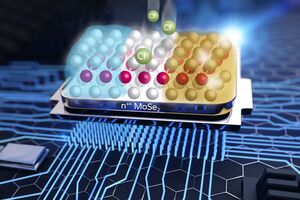
Ingeniously Two-Dimensional
"Efficiently doping the semiconductors of tomorrow Electronics of the future are inconceivable without two-dimensional materials. They are the great hope for high-performance and energy-efficient electronic components. At the same time, however, the unique properties of two-dimensional materials make it difficult to dope them with foreign atoms. This step is necessary to precisely adjust the electrical conductivity and to transform the material into a p- or n-type semiconductor. A team led by Dr. Slawomir Prucnal from the Helmholtz-Zentrum Dresden-Rossendorf (HZDR) with the help of Dr. Arkady Krasheninnikov’s research group at HZDR and Prof. Dietrich Zahn from the TU Chemnitz have now achieved a breakthrough, as the researchers in the scientific journal Nanoscale (DOI: 10.1039/D0NR08935D) report. The cover layer they use makes it possible to process the new materials with methods already established for conventional semiconductors." [...]

How physics breaks down in a black hole
"One of the most cherished laws of physics - the conservation of charge - has come under fire in “startling” research by physicists. The paper by Dr Jonathan Gratus from Lancaster University and Dr Paul Kinsler and Professor Martin McCall from Imperial College London demonstrates how the laws of physics break down in a black hole or “singularity”. “As the place where “physics breaks down” in a black-hole, we have the sense that anything might happen at a singularity. Although perhaps most useful as a plot device for science fiction stories, should we as concerned physicists nevertheless check what conservation laws might no longer hold?” The physicists investigated the behaviour of charge conservation which is the principle that the total electric charge in an isolated system never changes. To their surprise, they found that they could overturn this “usually sacrosanct principle of standard electromagnetism”. Dr Kinsler said: “By dropping an `axion-bomb' into a temporary singularity, such as an evaporating black hole, we can create or destroy electrical charge.” Axions are a hypothesised particle that are a candidate for dark matter, although their exact properties are still debated, and they have not yet been detected." [...]
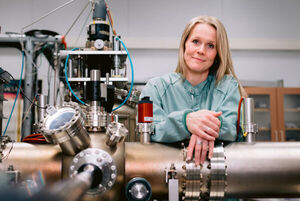
MXenes – the future of nanotechnology
"Artificial kidneys, powerful batteries and efficient water purification are some of the future applications of a group of ultrathin materials known as MXenes. This opinion is expressed in an article in the journal Science, whose authors include one from Linköping University. Materials that have a cross-section as thin as one or a few layers of atoms possess unusual properties due to their thickness. These properties may be high electrical conductivity, high strength or an ability to withstand heat, giving ultrathin materials a great potential for use in future technology. The most well-known material is graphene, and the hunt for other ultrathin materials, also known as two-dimensional materials, has increased in intensity since its discovery. Graphene and many other two-dimensional materials are either semiconductors, semimetals or polarised insulators." [...]

Physicists bring human-scale object to near standstill, reaching a quantum state
"The results open possibilities for studying gravity’s effects on relatively large objects in quantum states. To the human eye, most stationary objects appear to be just that — still, and completely at rest. Yet if we were handed a quantum lens, allowing us to see objects at the scale of individual atoms, what was an apple sitting idly on our desk would appear as a teeming collection of vibrating particles, very much in motion. In the last few decades, physicists have found ways to super-cool objects so that their atoms are at a near standstill, or in their “motional ground state.” To date, physicists have wrestled small objects such as clouds of millions of atoms, or nanogram-scale objects, into such pure quantum states. Now for the first time, scientists at MIT and elsewhere have cooled a large, human-scale object to close to its motional ground state. The object isn’t tangible in the sense of being situated at one location, but is the combined motion of four separate objects, each weighing about 40 kilograms." [...]
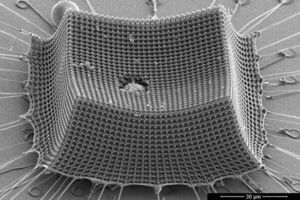
Ultralight material withstands supersonic microparticle impacts
"The new carbon-based material could be a basis for lighter, tougher alternatives to Kevlar and steel. A new study by engineers at MIT, Caltech, and ETH Zürich shows that “nanoarchitected” materials — materials designed from precisely patterned nanoscale structures — may be a promising route to lightweight armor, protective coatings, blast shields, and other impact-resistant materials. The researchers have fabricated an ultralight material made from nanometer-scale carbon struts that give the material toughness and mechanical robustness. The team tested the material’s resilience by shooting it with microparticles at supersonic speeds, and found that the material, which is thinner than the width of a human hair, prevented the miniature projectiles from tearing through it. The researchers calculate that compared with steel, Kevlar, aluminum, and other impact-resistant materials of comparable weight, the new material is more efficient at absorbing impacts. “The same amount of mass of our material would be much more efficient at stopping a projectile than the same amount of mass of Kevlar,” says the study’s lead author, Carlos Portela, assistant professor of mechanical engineering at MIT." [...]
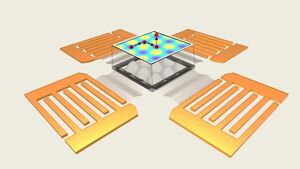
Sound-Induced Electric Fields Control the Tiniest Particles
"Acoustoelectronic tweezers gently manipulate biological nanoparticles just a few nanometers wide Engineers at Duke University have devised a system for manipulating particles approaching the miniscule 2.5 nanometer diameter of DNA using sound-induced electric fields. Dubbed “acoustoelectronic nanotweezers,” the approach provides a label-free, dynamically controllable method of moving and trapping nanoparticles over a large area. The technology holds promise for applications in the fields ranging from condensed matter physics to biomedicine. The research appears online on June 22 in Nature Communications. Precisely controlling nanoparticles is a crucial ability for many emerging technologies. For example, separating exosomes and other tiny biological molecules from blood could lead to new types of diagnostic tests for the early detection of tumors and neurodegenerative diseases." [...]

An artificial leaf made from semiconducting polymers
"EPFL scientists are generating oxygen from sunlight, water and semiconducting polymers. They present a promising way towards economical and scalable solar fuel production. Natural photosynthesis evolved to covert water and sunlight into oxygen (O2) and stored chemical energy. In plants this process is not very efficient, however the possibility to convert sunlight into chemical fuel in an economical and globally scalable manner is a very attractive method for reducing our dependence on fossil fuels. As such, scientists have been searching for routes toward efficient and inexpensive mimics of natural photosynthesis for decades. It turns out that the O2 production step is quite tricky and remains a major challenge toward artificial photosynthesis." [...]

Scientists Find Simple Method to Enhance Responsivity of Terahertz Radiation Detectors by 3.5 Folds
"Scientists of Tomsk Polytechnic University jointly with colleagues from Spanish universities have offered a simple method how to enhance the responsivity of terahertz radiation detectors by 3.5 folds using a small Teflon cube. The 1 mm cube must be put on the surface of the detector without changing the inner design of the detector. Such detectors are applied, for instance, in a full-body scanner, spectrometer, in medical devices for diagnosing skin cancer, burn injuries, pathological changes in blood. The research findings are published in the Optics Letter academic journal (IF: 3,714; Q1). Terahertz range lies between microwave and infrared ranges in the electromagnetic spectrum. Waves shorter than 1 mm refer to the terahertz range." [...]
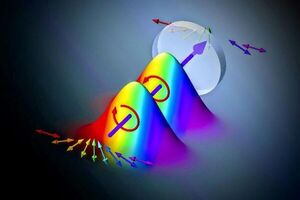
New high-speed method for spectroscopic measurements
"Researchers at Tampere University and their collaborators have shown how spectroscopic measurements can be made much faster. By correlating polarization to the colour of a pulsed laser, the team can track changes in the spectrum of the light by simple and extremely fast polarization measurements. The method opens new possibilities to measure spectral changes on a nanosecond time scale over the entire colour spectrum of light. In spectroscopy, often the changes of the wavelength, i.e. colour, of a probe light are measured after interaction with a sample. Studying these changes is one of the key methods to gain a deeper understanding of the properties of materials down to the atomic level." [...]
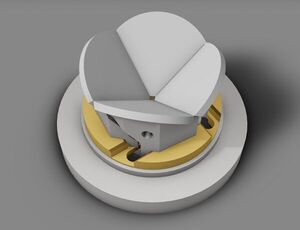
New Cold Atom Source Lays Groundwork for Portable Quantum Devices
"Technology advance could enable space-based atomic clocks, improving communications and GPS navigation Although quantum technology has proven valuable for highly precise timekeeping, making these technologies practical for use in a variety of environments is still a key challenge. In an important step toward portable quantum devices, researchers have developed a new high-flux and compact cold-atom source with low power consumption that can be a key component of many quantum technologies. “The use of quantum technologies based on laser-cooled atoms has already led to the development of atomic clocks that are used for timekeeping on a national level,” said research team leader Christopher Foot from Oxford University in the U.K. “Precise clocks have many applications in the synchronization of electronic communications and navigation systems such as GPS. Compact atomic clocks that can be deployed more widely, including in space, provide resilience in communications networks because local clocks can maintain accurate timekeeping even if there is a network disruption.” In The Optical Society (OSA) journal Optics Express, S. Ravenhall, B. Yuen and Foot describe work carried out in Oxford, U.K. to demonstrate a completely new design for a cold atom source. The new device is suitable for a wide range of cold-atom technologies. “In this project we took a design we made for research purposes and developed it into a compact device,” said Foot." [...]
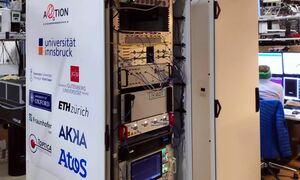
Compact quantum computers for server centers
"So far, quantum computers have been one-of-a-kind devices that fill entire laboratories. Now, physicists at the University of Innsbruck have built a prototype of an ion trap quantum computer that can be used in industry. It fits into two 19-inch server racks like those found in data centers throughout the world. Over the past three decades, fundamental groundwork for building quantum computers has been pioneered at the University of Innsbruck, Austria. As part of the EU Flagship Quantum Technologies, researchers at the Department of Experimental Physics in Innsbruck have now built a demonstrator for a compact ion trap quantum computer. "Our quantum computing experiments usually fill 30- to 50-square-meter laboratories," says Thomas Monz of the University of Innsbruck." [...]

Modeling A Circular Economy For Electronic Waste
"New research from the Hypothetical Materials Lab at the University of Pittsburgh Swanson School of Engineering develops a framework to understand the choices an electronic waste recycler has to make and the role that digital fraud prevention could have in preventing dishonest recycling practices. Think about how many different pieces of technology the average household has purchased in the last decade. Phones, TVs, computers, tablets, and game consoles don’t last forever, and repairing them is difficult and often as expensive as simply buying a replacement. Electronics are integral to modern society, but electronic waste (e-waste) presents a complex and growing challenge in the path toward a circular economy—a more sustainable economic system that focuses on recycling materials and minimizing waste. Adding to the global waste challenge is the prevalence of dishonest recycling practices by companies who claim to be recycling electronics but actually dispose of them by other means, such as in landfills or shipping the waste to other countries. New research from the Hypothetical Materials Lab at the University of Pittsburgh Swanson School of Engineering develops a framework to understand the choices a recycler has to make and the role that digital fraud prevention could have in preventing dishonest recycling practices." [...]
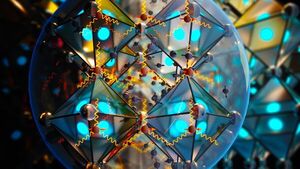
Common Perovskite Superfluoresces at High Temperatures
"A commonly studied perovskite can superfluoresce at temperatures that are practical to achieve and at timescales long enough to make it potentially useful in quantum computing applications. The finding from North Carolina State University researchers also indicates that superfluorescence may be a common characteristic for this entire class of materials. Superfluorescence is an example of quantum phase transition – when individual atoms within a material all move through the same phases in tandem, becoming a synchronized unit. For example, when atoms in an optical material such as a perovskite are excited they can individually radiate light, create energy, and fluoresce. Each atom will start moving through these phases randomly, but given the right conditions, they can synchronize in a macroscopic quantum phase transition. That synchronized unit can then interact with external electric fields more strongly than any single atom could, creating a superfluorescent burst." [...]
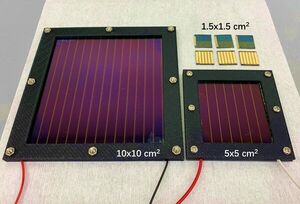
Future of perovskite solar cells shines a little brighter
"Solar cells, which convert sunlight to electricity, have long been part of the global vision for renewable energy. Although individual cells are very small, when upscaled to modules, they can be used to charge batteries and power lights. If laid side-by-side, they could, one day, be the primary energy source for buildings. But the solar cells currently on the market utilize silicon, which makes them expensive to fabricate when compared to more traditional power sources. That’s where another, relatively new-to-science, material comes in – metal halide perovskite. When nestled at the center of a solar cell, this crystalline structure also converts light to electricity, but at a much lower cost than silicon." [...]

Changing a 2D Material’s Symmetry Can Unlock Its Promise
"Optoelectronic materials that are capable of converting the energy of light into electricity, and electricity into light, have promising applications as light-emitting, energy-harvesting, and sensing technologies. However, devices made of these materials are often plagued by inefficiency, losing significant useful energy as heat. To break the current limits of efficiency, new principles of light-electricity conversion are needed. For instance, many materials that exhibit efficient optoelectronic properties are constrained by inversion symmetry, a physical property that limits engineers’ control of electrons in the material and their options for designing novel or efficient devices. In research published today in Nature Nanotechnology, a team of materials scientists and engineers, led by Jian Shi, an associate professor of materials science and engineering at Rensselaer Polytechnic Institute, used a strain gradient in order to break that inversion symmetry, creating a novel optoelectronic phenomenon in the promising material molybdenum disulfide (MoS2) — for the first time. To break the inversion symmetry, the team placed a vanadium oxide (VO2) wire underneath a sheet of MoS2." [...]
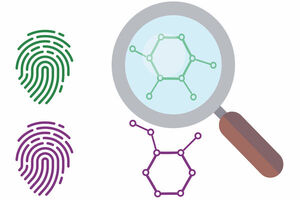
Algorithm Uses Mass Spectrometry Data to Predict Identity of Molecules
"New method saves time, money in developing new drugs An algorithm designed by researchers from Carnegie Mellon University's Computational Biology Department and St. Petersburg State University in Russia could help scientists identify unknown molecules. The algorithm, called MolDiscovery, uses mass spectrometry data from molecules to predict the identity of unknown substances, telling scientists early in their research whether they have stumbled on something new or merely rediscovered something already known. This development could save time and money in the search for new naturally occurring products that could be used in medicine. "Scientists waste a lot of time isolating molecules that are already known, essentially rediscovering penicillin," said Hosein Mohimani, an assistant professor and part of the research team. "Detecting whether a molecule is known or not early on can save time and millions of dollars, and will hopefully enable pharmaceutical companies and researchers to better search for novel natural products that could result in the development of new drugs." The team's work, "MolDiscovery: Learning Mass Spectrometry Fragmentation of Small Molecules," was recently published in Nature Communications." [...]

Graphene ‘camera’ captures real-time electrical activity of beating heart
"Bay Area scientists have captured the real-time electrical activity of a beating heart, using a sheet of graphene to record an optical image — almost like a video camera — of the faint electric fields generated by the rhythmic firing of the heart’s muscle cells. The graphene camera represents a new type of sensor useful for studying cells and tissues that generate electrical voltages, including groups of neurons or cardiac muscle cells. To date, electrodes or chemical dyes have been used to measure electrical firing in these cells. But electrodes and dyes measure the voltage at one point only; a graphene sheet measures the voltage continuously over all the tissue it touches. The development, published online last week in the journal Nano Letters, comes from a collaboration between two teams of quantum physicists at the University of California, Berkeley, and physical chemists at Stanford University. “Because we are imaging all cells simultaneously onto a camera, we don’t have to scan, and we don’t have just a point measurement." [...]
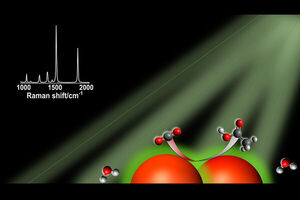
Light-harvesting nanoparticle catalysts show promise in quest for renewable carbon-based fuels
"Researchers report that small quantities of useful molecules such as hydrocarbons are produced when carbon dioxide and water react in the presence of light and a silver nanoparticle catalyst. Their validation study – made possible through the use of a high-resolution analytical technique – could pave the way for CO2-reduction technologies that allow industrial-scale production of renewable carbon-based fuels. The study, led by University of Illinois Urbana-Champaign chemistry professor Prashant Jain, probes chemical activity at the surface of silver nanoparticle catalysts under visible light and uses carbon isotopes to track the origin and production of these previously undetected chemical reactions. The findings are published in the journal Nature Communications. Sunlight-driven conversion of CO2 and water into energy-dense multicarbon compounds is a viable technology for renewable energy generation and chemical manufacturing. Because of this, researchers have been on the hunt for synthetic catalysts that facilitate large-scale CO2 reduction into multicarbon molecules, the study reports." [...]
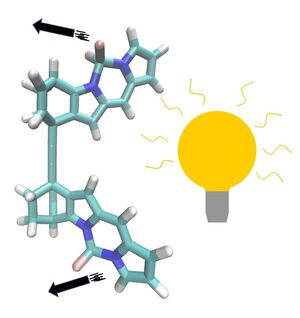
University of Groningen scientists design superfast molecular motor
"Light-driven molecular motors have been around for over twenty years. These motors typically take microseconds to nanoseconds for one revolution. Thomas Jansen, associate professor of physics at the University of Groningen, and Master’s student Atreya Majumdar have now designed an even faster molecular motor. The new design is driven by light only and can make a full turn in picoseconds, using the power of a single photon. Jansen: ‘We have developed a new out-of-the-box design for a motor molecule that is much faster.’ The design was published in The Journal of Physical Chemistry Letters on 7 June. The new motor molecule design started with a project in which Jansen wanted to understand the energy landscape of excited chromophores." [...]

Physicists at Georgia Tech and engineers at UC Santa Barbara are exploring the shallow underground world with a burrowing soft robot
"We’ve seen robots take to the air, dive beneath the waves and perform all sorts of maneuvers on land. Now, researchers at UC Santa Barbara and Georgia Institute of Technology are exploring a new frontier: the ground beneath our feet. Taking their cues from plants and animals that have evolved to navigate subterranean spaces, they’ve developed a fast, controllable soft robot that can burrow through sand. The technology not only enables new applications for fast, precise and minimally invasive movement underground, but also lays mechanical foundations for new types of robots. “The biggest challenges with moving through the ground are simply the forces involved,” said Nicholas Naclerio, a graduate student researcher in the lab of UC Santa Barbara mechanical engineering professor Elliot Hawkes and lead author of a paper on the cover of the journal Science Robotics. Whereas air and water offer little resistance to objects moving through them, he explained, the subterranean world is another story." [...]

Atomic-scale tailoring of graphene approaches macroscopic world
"Properties of materials are often defined by imperfections in their atomic structure, especially when the material itself is just one atom thick, such as graphene. Researchers at the University of Vienna have now developed a method for controlled creation of such imperfections into graphene at length scales approaching the macroscopic world. These results, confirmed by atomically resolved microscope images and published in the journal Nano Letters, serve as an essential starting point both for tailoring graphene for applications and for the development of new materials. Graphene consists of carbon atoms arranged in a chicken-wire like pattern. This one-atom-thick material is famous for its many extraordinary properties, such as extreme strength and remarkable capability to conduct electricity. Since its discovery, researchers have looked for ways to further tailor graphene through controlled manipulation of its atomic structure." [...]
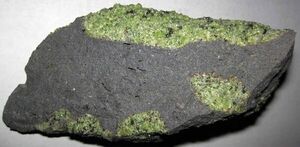
Rock crystals from the deep give microscopic clues to earthquake ground movements
"Microscopic imperfections in rock crystals deep beneath Earth’s surface play a deciding factor in how the ground slowly moves and resets in the aftermath of major earthquakes, says new research involving the University of Cambridge. The stresses resulting from these defects – which are small enough to disrupt the atomic building blocks of a crystal – can transform how hot rocks beneath Earth’s crust move and in turn transfer stress back to Earth’s surface, starting the countdown to the next earthquake. The new study, published in Nature Communications, is the first to map out the crystal defects and surrounding force fields in detail. “They’re so tiny that we’ve only been able to observe them with the latest microscopy techniques,” said lead author Dr David Wallis from Cambridge Earth Sciences, “But it’s clear that they can significantly influence how deep rocks move, and even govern when and where the next earthquake will happen”. By understanding how these crystal defects influence rocks in the Earth’s upper mantle, scientists can better interpret measurements of ground motions following earthquakes, which give vital information on where stress is building up - and in turn where future earthquakes may occur. Earthquakes happen when pieces of Earth’s crust suddenly slip past each other along fault lines, releasing stored-up energy which propagates through the Earth and causes it to shake." [...]
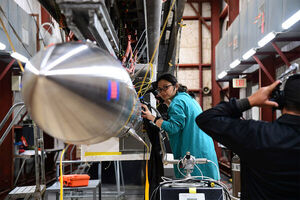
CIBER-2 experiment successfully completes first flight
"By sending a Black Brant IX rocket on a 15-minute flight to space and back, researchers from Rochester Institute of Technology, Caltech, Kwansei Gakuin University, and Korea Astronomy and Space Science Institute glimpsed traces of light from the earliest stages of the universe. The Cosmic Infrared Background Experiment-2 (CIBER-2) completed a successful first launch on June 7 at the White Sands Missile Range in New Mexico, the first of four planned over the next several years. Led by principal investigator Michael Zemcov, an assistant professor in RIT’s School of Physics and Astronomy and Center for Detectors, the experiment aims to better understand extragalactic background light, which traces the history of galaxies back to the formation of the first stars in the universe. Zemcov said data collected by the study could help resolve discrepancies about how many stars exist in the universe. “Scientists do this measurement different ways and we’re having a really hard time to make the results of those different ways agree,” said Zemcov. “So there’s a mystery going on." [...]
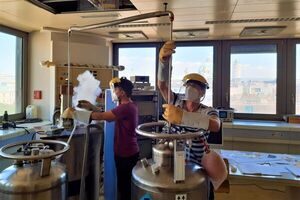
Exotic superconductors: The Secret that wasn’t there
"How reproducible are measurements in solid-state physics? New measurements show: An allegedly sensational effect does not exist at all. A single measurement result is not a proof - this has been shown again and again in science. We can only really rely on a research result when it has been measured several times, preferably by different research teams, in slightly different ways. In this way, errors can usually be detected sooner or later. However, a new study by Prof. Andrej Pustogow from the Institute of Solid State Physics at TU Wien together with other international research teams shows that this can sometimes take quite a long time." [...]
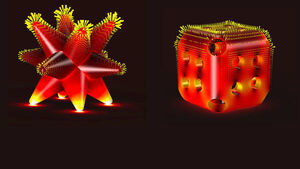
Metal catalysts used for environmental sustainability found to degrade and become less effective
"Some tiny catalysts being considered for industrial-scaled environmental remediation efforts may be unstable during operation New research is showing that some tiny catalysts being considered for industrial-scaled environmental remediation efforts may be unstable during operation. Chemists from the University of Waterloo studied the structures of complex catalysts known as “nanoscale electrocatalysts” and found that they are not as stable as scientists once thought. When electricity flows through them during use, the atoms may rearrange. In some cases, the researchers found, electrocatalysts degrade completely. Understanding why and how this rearrangement and degradation happens is the first step to using these nanoscale electrocatalysts in environmental remediation efforts such as removing atmospheric carbon dioxide and groundwater contaminants and transforming them into higher-value products such as fuels. “Current electrocatalysts rely on complex nanoscale structures in order to optimize their efficiency,” said Anna Klinkova, a professor in Waterloo’s Department of Chemistry." [...]

Scientists develop energy saving technique which could help pave way for a carbon neutral society
"Researchers at the University of Bristol have discovered a method which will allow for faster communication systems and better energy saving electronics. The breakthrough was made by establishing how to remotely measure the electric field inside a semiconductor device for the first time. A semiconductor is a material, such as Silicon, which can be used in electronic devices to control electric current. Now, in this new study, published today in Nature Electronics, scientists outline how to precisely quantify this electric field, meaning next generation power and radio frequency electronic devices can be developed which have the potential to be faster, and more reliable, as well as more energy efficient. Semiconductor device design can be trial and error, though more commonly it is based on a device simulation which then provides the basis for the manufacture of the semiconductor devices for real life applications. When these are new and emerging semiconductor materials, it has often been unknown how accurate and correct these simulations actually are." [...]
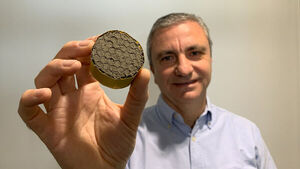
Meringue-like material could make aircraft as quiet as a hairdryer
"Extremely low-density graphene-based aerogel ‘meringue’ can improve passenger comfort and reduce noise up to 80% An incredibly light new material that can reduce aircraft engine noise and improve passenger comfort has been developed at the University of Bath. The graphene oxide-polyvinyl alcohol aerogel weighs just 2.1kg per cubic metre, making it the lightest sound insulation ever manufactured. It could be used as insulation within aircraft engines to reduce noise by up to 16 decibels - reducing the 105-decibel roar of a jet engine taking off to a sound closer to that of a hair-dryer. The aerogel’s meringue-like structure makes it extremely light, meaning it could act as an insulator within aircraft engine nacelles, with almost no increase in overall weight. The material is currently being further optimised by the research team to offer improved heat dissipation, offering benefits to fuel efficiency and safety. Researchers from Bath’s Materials and Structures Centre (MAST) have published a method for manufacturing the materials in the journal Nature Scientific Reports." [...]

Let there be light! New tech for night vision
"Researchers from The Australian National University (ANU) have developed new technology that allows people to see clearly in the dark, revolutionising night-vision. The first-of-its-kind thin film, described in a new article published in Advanced Photonics, is ultra-compact and one day could work on standard glasses. The researchers say the new prototype tech, based on nanoscale crystals, could be used for defence, as well as making it safer to drive at night and walking home after dark. The team also say the work of police and security guards - who regularly employ night vision - will be easier and safer, reducing chronic neck injuries from currently bulk night-vision devices. "We have made the invisible visible," lead researcher Dr Rocio Camacho Morales said. "Our technology is able to transform infrared light, normally invisible to the human eye, and turn this into images people can clearly see - even at distance." [...]
Documentação
A documentação é parte essencial do processo de aprendizagem e a Internet além de artigos interessantes de explorar também tem alguma documentação em formato PDF interessante de ler. Todos os links aqui apresentados são para conteúdo disponibilizado livremente pelo editor do livro.

The MagPI 107
"Inside The MagPi magazine #107 - Become a Raspberry Pi genius. Gain a deeper understanding of Raspberry Pi and learn essential maintenance techniques. - Make a weather watcher. Use Raspberry Pi and an e-ink display to tap into a Weather API and build an always-on weather watcher. - Recreate the Mars helicopter. One maker has used NASA’s F prime open-source operating system (being used to control Ingenuity on Mars) with an off-the-shelf drone." [...]
Projetos Maker
Diversos Projetos interessantes.

Make An Arduino Tic Tac Toe Game With An AI Opponent
"Today we’re going to be building a Tic Tac Toe or Noughts and Crosses shield for an Arduino. The game board is made up of a 3×3 grid of RGB LEDs that light up green or blue to indicate the naughts or crosses. A keypad at the bottom of the shield, that corresponds to the game board positions allows you to input each move. A status LED underneath the gameboard shows you which player’s turn it is and allows you to select one of the three game modes using the start button alongside it. The game has 3 selectable game modes, the first is a turn-by-turn two-player mode that allows you to play against another person, the second is an easy level AI opponent and the third is an expert level AI opponent that is impossible to beat. How The AI Algorithm Works The AI works on a minimax algorithm, which is a recursive algorithm aimed at minimising the possible loss for a worst-case scenario." [...]

DIY Water Level Indicator
"Make a water level indicator without using any microcontroller or programming. Just with simple electronic components! We have seen many DIY water level indicators which are made using Arduino UNO or any other microcontrollers. This adds up to the list of components and the budget too. If you want a cheap device for indicating the water levels of any water storage tank, we would need a good cheaper alternative. This project is all about making such water level indicator that can give you very accurate and reliable output." [...]
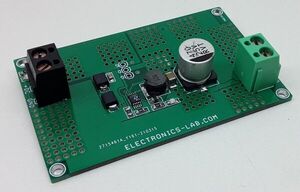
Active Rectifier Controller with Reverse Protection for Battery and Solar cell
"This demonstration circuit is an active rectifier with reverse protection for batteries in automotive applications. The project is designed for 5A load current. Two clamping diodes, D1 and D2, are used on the board to protect the IC from overvoltage spikes at the input. The input supply range is 12V to 24V. The active rectifier controller chip LT8672 controls an external N-channel MOSFET (Q1) to form an ideal diode. The GATE amplifier senses across DRAIN and SOURCE and drives the gate of the MOSFET to regulate the forward voltage to 20mV." [...]
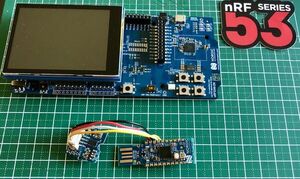
Posture Watchdog
"A wearable which accurately monitors your sitting posture and activities using machine learning and alerts you. Overview Before COVID19 people had to do some physical activity willingly or unwillingly in their normal life activities. For example they had to commute to schools, offices or business places. During the COVID19 many people have changed their lifestyle. Most of them have started working remotely from home with restricted physical activities. Also, in schools or offices you have to maintain your sitting postures but at home you are free to seat or lay in any posture at your own comfort or out of laziness while working." [...]

Nordic Sense Gloves
"Wearable Infrared thermometer with Bluetooth connectivity. Its was my wish to make something with Nordic Dongle, unfortunately I did not made. When I get these kits from Nordic team during CES event, I promise them I make something with this for sure one day. And finally the day came after seeing the "Advance Wearable" contest I decided to use the dongle here as a wearable device. Wearable Thermometer I think the IR thermometer reached everyone hands and used widely due to the pandemic situation. Its not surprise to see any guy with wearing gloves and holding the thermometer." [...]
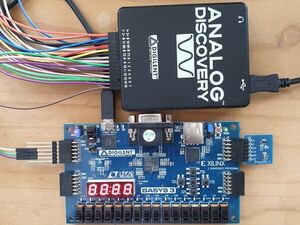
SPI Interface Code for Pmod ALS (8-bit ADC) in Verilog
"SPI Interface code for Pmod ALS (8-bit ADC) in Verilog is implemented from scratch,and transmitted to 7-seg display on Basys3 FPGA board. Story In this project, SPI Interface code is written in Verilog to interface an 8-bit ADC from Pmod-ALS. The 8-bit binary is converted to BCD and displayed on 7-segment display. The verilog code is synthesized on Artix-7 FPGA from Basys 3 board. About me.. I have started to learn Verilog and it is very fulfilling and super exciting to think in terms of hardware." [...]

CaribouLite - 6GHz SDR HAT for Raspberry Pi
"A HAT Turning any 40-pin Raspberry Pi into a dual-channel Software-Defined-Radio (SDR) Story CaribouLite is an SDR (Software Defined Radio) product answering the following questions: How do you make a Software Defined Radio which is portable, capable, and affordable. The motivation came from the current communication systems in UAVs and UGVs in which a self-contained communication system is a must, and it needs to be lightweight and support multiple protocols. We came up with an answer - take the most popular Brain (the raspberry pi) that every engineer is familiar with, and expand it with the widest possible radio transceiver. CaribouLite is capable of transmitting and receiving in two parallel channels - (1) a wide 30-6000 MHz channel, and (2) a sub-1GHz channel. The immediate bandwidth (2.5MHz with 4 MSPS ADC and DAC) is sufficient for most IoT communication. The SDR is fully integrated inside the #RaspberryPi Linux software and OS." [...]

Laser Harp
"This is a musical instrument that uses MIDI communication, lasers, and photoresistors to generate sounds. Story To create this instrument, I took inspiration from other existing laser harp models, which however are very bulky and expensive. My goal was therefore to reduce its size to make it easier to transport and simplify its structure in order to make it more intuitive and accessible to a greater number of people. The use is very simple and intuitive. Just connect the instrument to the sound card with a MIDI cable and the sound card to the computer with DAW software installed for processing MIDI signals. In this case, I'm using an iPad with Garage Band installed." [...]

Arduino M&M Color Sorter
"Are you tired of sorting your m&ms by hand? Looking for a silly way to spend your time and 3D printer filament? Then this is the Instructable for you. This is a project that I built for one of my engineering courses, in which we were challenged to use an Arduino, some basic electrical components, and a 3D printer to build something creative that implemented sensing, actuation, and autonomous sequencing. I chose to tackle the important problem of unsorted m&m candies. This project took several weeks of testing and iteration, so in this Instructable I will just be explaining my final design, with notes on the design process and tips for how to build one yourself." [...]

AI- Personal Fitness Trainer
"AI based fitness trainer. It can be considered as your personal fitness trainer. This project is a AI based fitness training. Recently lot of people facing many health issues due to the lack of physical activity. Not getting enough physical activity can lead to heart disease, even for people who have no other risk factors. It can also increase the likelihood of developing other heart disease risk factors, including obesity, high blood pressure, high blood cholesterol." [...]

Audio Visualizer using Raspberry Pi
"Project that creates a play of lights on the led strip according to the sounds captured around it. In general, people love music, and also the lights, that's why we thought of uniting them and getting to create this project. It is useful for ambiance, for decor lovers who include LED strips. It is a project that can be folded on several needs, being possible to place it in different shapes or places, depending on the desire of each (for example, we can create a picture frame, we can hang the LEDs in the corners or behind the TV, and ideas can go on and on). Technology today has managed to develop extremely fast and amazing. It will always manage to bring a plus in our life and improve it." [...]

STM32 Tiny Monitor
"A super tiny monitor for your PC, suitable for your pet ant. A python script sends the captured screen over USB to the STM32 microcontroller, then that data is displayed on ST7789 display. FPS is not that high, but I made it good enough after several optimizations. " [...]
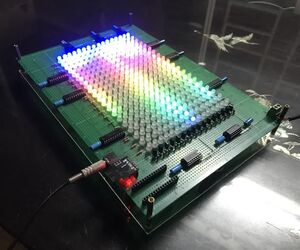
ATtiny85 - Spectrum Analyzer on RGB Led Matrix 16x20
"Continuing with ATtiny85, today I'd like to share how to build a music spectrum analyzer on 16x20 RGB led matrix. The music signal FFT transformation and LED Bit Angle Modulation are all carried out by one DigiSpark ATtiny85. Main components are as follows: 1 x DigiSpark ATtiny85. 320 x 5mm Common Anode RGB LEDs. 16 x A1013 Transistors. 2 x Shift Register 74HC595N." [...]
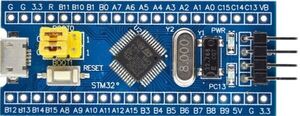
Bluepill Diagnostics V1.6
"My Blue Pill Diagnostics project grew from an interest to create a self contained binary that would boot on a (64KB flash) Blue Pill board and access internal JDEC, DEBUG, ID and hardware information via USB and a Serial Terminal on the PC. This information would be then used to determine the mcu MAKE and MODEL. V1.0 was released in November 2019 and it has taken two years to collate and study user clone/fake information because not a lot is known about these counterfeits which are usually (mis)labelled as genuine STMicrolectronics chips much to the annoyance of the Chinese MCU manufacturers who I’m informed license the Cortex-M3 core from ARM. This interest was kindled by various forum articles from Blue Pill owners who had dodgy boards and no way to ‘look inside the chip’. " [...]

The NEORV32 RISC-V Processor
"The NEORV32 Processor is a customizable microcontroller-like system on chip (SoC) that is based on the RISC-V NEORV32 CPU. The project is intended as auxiliary processor in larger SoC designs or as ready-to-go stand-alone custom / customizable microcontroller. " [...]
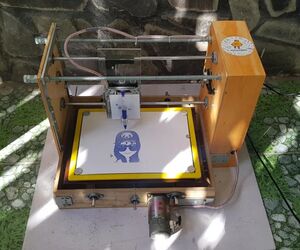
Homemade CNC Machine From DC Servo Motors and Wooden Wine Boxes
"Today, I would like to share how to build a 3 axis CNC machine at home using available or discarded materials. Specifically in this project, I reused 2 old DC servo motors and 2 wooden wine boxes, as well as, taking advantage of my daughter's unused school supplies. The main materials are used in this project: 1pcs x Big Wooden Wine Box, dimension W x L x H x T: 350 x 400 x 80 x 8mm. 1pcs x Small Wooden Wine Box, dimension W x L x H x T: 220 x 340 x 100 x 10mm. 1pcs x Arduino Uno R3. 1pcs x Arduino Mega 2560." [...]
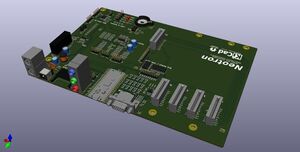
Neotron Pico
"A Neotron system powered by the Raspberry Pi Pico, in a micro-ATX form-factor. The Neotron Pico is based around the idea of the Neotron-32, but using a low-cost Raspberry Pi Pico instead of a Texas Instuments Tiva-C Launchpad. It also stretches out to full micro-ATX size, and adds more expansion slots so that you can easily design and add your own peripherals. The Raspberry Pi Pico is the core of the Neotron Pico. It uses PIO statemachines to generate 12-bit Super VGA video, and digital 16 bit 48 kHz stereo audio. It also has both I²C and SPI buses." [...]
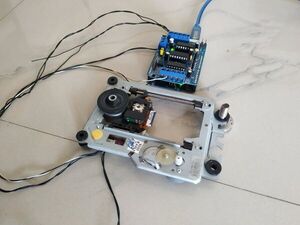
Arduino DVD motor
"Driving DVD motor using an arduino UNO and motor shield In this project I am going to Drive SLED-Motor and SPINDLE-Motor of a DVD player using an Arduino Uno and An Adafruit Motor Shield. So Let's get started. LIST OF HARDWARES: Arduino UNO Adafruit Motor shield Arduino UNO programming cable Copper Wires Screw Driver DVD LENS mechanism" [...]

Infrared Remote Decoder/Tester
"A simple decoder or tester for infrared remote controls. Great for obtaining the command code for each button on the remote. Going through boxes of junk that had been collected over a number of years, I came across dozens of infrared remote controls from various VCR's, TVs, LED strips etc. I thought I might keep some for say controlling a robotic car or other such projects. I needed a way of not only testing these remotes but also obtaining the command codes for each of their buttons. This build is a simple decoder and tester for infrared remote controls." [...]

Programable LEDstrip Module 1.0, 2.0
"A LED strip development multipurpose module Hello everyone, this is my first project here as well as my first intermediate Arduino project. Everything started when I bought the cheap LED strip a while back soon after soon I started getting curious whether I could control it with my computer. That's when I first got introduced to and started working with Arduino. In this project, I will show you through my full build. " [...]

Health Monitor
"It is very practical to see the datas that somes sensors are collecting. Monitoring patients' vital signs like heart rate, oxygen saturation and temperature can be sometimes mandatory in some situations. Sometimes, it can also be useful to know other things like the patient state or if he has convulsions. In this case, IMUs can be used to know these factors. This project is not perfect and I really encourage you to modify and to improve different aspects, mainly the Bluetooth connection between the nRF5340 DK and the Arduino Nano 33 BLE. Theworkingprinciples Arduino Nano 33 BLE The working principle of this project is very simple." [...]
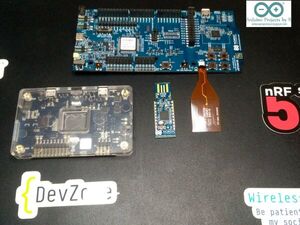
Health Network Wearable: Remote patient monitoring system
"Healthcare automation has always been a popular topic among everyone, but now, amid this pandemic, it is a necessity. We have all seen remote patient monitoring systems and health trackers, we have seen customized apps that can send alerts or notifications when critical vital signs are recorded. Healthcare automation has always been a popular topic among medical professionals and public, but now, amid this pandemic, it is a necessity and it is always a necessity in places where there is lack of medical professionals and health care providers. Aim/ Objective I am going to build a Health Network which will connect the patients vital measurement data and feed them to the Health Network device. The data will then be displayed in the app. This could be a new introduction to healthcare automation and would also require less medical professionals and healthcare providers." [...]

Lor's matrix glasses
"DIY (NO PCB) LED matrix glasses using 3mm LEDs! LED Matrix glasses made with discrete 3mm LEDs using their leads as the matrix frame. I started working on this project out of nowhere and a little over 2 days later I had my own LED matrix glasses. It took a whole night to dry the epoxy glue mixed with black fabric color but, if I had some quick black epoxy the project was just a one-night project. If I go back and redo this project I will not use magnet wire for connections 😢 very bad decision! This is one of the projects that I am very proud of because it required a lot of engineering and creativity at the same time." [...]

ESP8266 ESP-01 Smart Door / Smart Intercom
"ESP8266 Arduino project smart intercom ESP-01, The best Arduino project. We made a smart intercom using Esp8266 with Arduino. By using the Internet of Things IOT, you can access the intercom in your home from anywhere with the Internet. Control your Arduino project with the mobile app. as well as from all over the world. " [...]

Office Clock using RaspberryPi
"Digital office clock, also displaying interior and exterior temperatures, made with RaspberryPi Zero W and a 16x16 Led Matrix Screen. Ever hated the fact that you have to walk to the thermostat to see if the room temperature is good enough, or that you have to do 5 different swipe gestures on your phone to get to the weather app, just to find out if you need to wear a jacket or only a t-shirt when you want to go outside? This solution unifies these things into one small and fun project, where you get all the data you want at a single glance. Presentation The clock has two views: the "digital clock" and a "temperatures" view where it displays the current interior temperature retrieved by the DHT11 sensor and the weather at the current location parsed from the IP address of the connection (if it exists). If the clock can't parse any of the two temperatures, it will display two dashes as a placeholder. " [...]

Lora Weather Station With Arduino
"Simple Weather Station With Lora, Arduino & Sensors Today iam going to show you how to make LoRa (rfm95) Weather Station With Arduino & Sensors this is a simple project does not require high knowledge about arduino and electronics this is an intermediate level project, so its kind of okay to you. " [...]
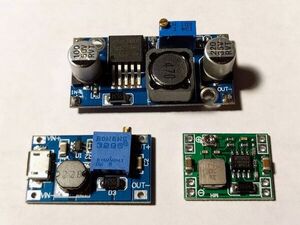
DIY DC to DC Buck Converter (Step Down)
"DC-DC Buck Converter to step down voltages from 55V max to 1.2V-55V We often need to supply our circuits with some specific amount of voltage to our circuits like a 5V DC circuit powering microcontrollers like Arduino. These circuits have a maximum tolerance of 5V. If the voltage level goes beyond that, it can burn out the microcontroller. Thus, a regulated power supply is very important. The main question arises that how can we get regulated 5V or any other power supply. It's not possible many times to arrange the batteries of the exact voltages." [...]

breadWare
"A jumperless breadboard breadWare is a prototyping tool where jumper connections can be made by sending commands from a computer instead of placing physical wires. The onboard ATmega4809 can also read and write any analog (±9V) voltage to anywhere on the breadboard. That means with the right desktop app, you could prototype the circuits with someone else over the internet as if your boards were physically right next to each other. Or save a circuit on your computer and load it up later by just placing the components again. Or a million other things I haven't thought of yet. You also can connect 5 of the GPIO pins so you basically have an Arduino Nano Every hidden inside a breadboard." [...]

Deej - a Physical Volume Mixer
"Meet deej! deej is a physical voulume mixer. Just like the volume mixer built into windows, just physical! This means that you can change the volume of an application without closing your important game. You can turn the game volume down and Discord volume up, when someone joins the call, and turn the Spotify volume up when your beat comes on. Since it sits right beside your keyboard you can quickly change volume, for example if a game has a loud intro music (looking at you Civ 6)." [...]
Secção Videos
Videos interessantes.
That's all Folks!





